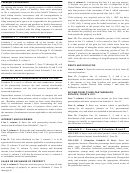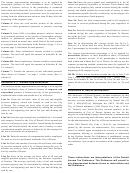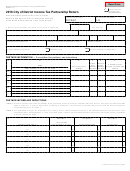Instructions For Form 5458 - City Of Detroit Income Tax Partnership Return Page 2
ADVERTISEMENT
Line 5, column 1: Calculating this line is a two-step process:
Taxpayer Certification
1) Exclude any gain or loss on the sale of obligations of the
By signing this return, the signing partner or officer declares
United States which are included in line 4; 2) enter on line 5
that the filer has power of attorney from each participant
only that portion of the remainder of line 4 which represents
to file a composite return on his or her behalf. Treasury will
gain or loss attributable to the period after July 1, 1962.
mail refund checks, assessments and all correspondence to
If the property was acquired prior to July 1, 1962, the basis
the filing company at the address indicated on the return. The
may be the adjusted fair market value of the property on July
filing company must agree to be responsible for the payment of
1, 1962, (July 2 closing price for traded securities), or the gain
any additional tax, interest and penalties as finally determined.
or loss applicable to the period after June 30, 1962, may be
Issues involving the tax liability reported on a composite
computed by multiplying the total gain or loss by the ratio of
return will be resolved with the filing company. In unusual
the months the property was held after June 30, 1962, to the
circumstances, Treasury may contact the participants.
total months the property was held.
Schedule C — Income from Partnership
Line 12: The nonresident excludable portion of the amount
shown in line 12, column 3, to be entered in line 12, column
Schedule C is used to indicate all of the income of the
4, is that portion of the gain (or loss) which arose from the
partnership which may be subject to the Detroit tax. Line 28 of
sale or exchange of intangible assets, and of tangible property
Schedule C reflects the total of the partnership ordinary income
located outside of Detroit. The remaining portion of line 12,
from business operations, and lines 29 through 31 of Schedule
column 3, which is to be entered on line 12, column 5, will then
C reflects the total nonbusiness income of the partnership.
include gain (or loss) attributable to the period after June 30,
Ordinary income from business on Schedule C, line 28, will
1962, from the sale or exchange of tangible property located in
carry to Schedule E, column 1.
Detroit.
Nonbusiness income on Schedule C, lines 25 through 40, will
RENTS AND ROYAlTIES
carry to Schedule B. Instructions for Schedules B and E will
Line 6, column 1: Enter the total net income (or loss) from all
indicate how amounts transferred from Schedule C are to be
rents and royalties.
allocated to the individual partners.
Line 13: Complete line 13, columns 2, 3, and 4, as a
SChEDulE B — Nonbusiness Income or loss
distribution of the amount entered in line 6. Subtract column
4 (net income or loss from royalties and rents attributable
Schedule B is used to allocate the total nonbusiness income
to property outside Detroit) from column 3 and enter the
of the partnership between the total amount distributable
difference in column 5.
to resident partners and the total amount distributable to
nonresident partners.
INCOME FROM OThER PARTNERShIPS,
ESTATES, TRuSTS, ETC.
Nonresident income is further allocated to compute the total
income of nonresident partners which is subject to the Detroit
Line 7, column 1: Enter the net income (or loss) from other
tax. (Resident partners are taxed on their entire distributive
partnerships and other income from Schedule C, line 32.
share of nonbusiness income.) After determining the total
Line 8, column 1: Enter any income which is specifically
taxable income for each class of partners, these totals are
exempt for all taxpayers (interest on U.S. governmental
transferred to Schedule E wherein an analysis is made to show
obligations, etc.) and which was included in the amount on line 7.
the amounts of nonbusiness income applicable to the individual
partners.
Line 14: Complete line 14, columns 2, 3, and 4, as a
distribution of the amount entered in line 9. Subtract column 4
INTEREST AND DIVIDENDS
(income not taxable to nonresidents) from column 3 and enter
Line 1, column 1: Enter the total partnership income from
the difference in column 5.
interest and dividends from Schedule C, line 31.
Schedule E — Summary of Schedules B and C
Line 2, column 1: Deduct the total nontaxable interest (interest
from obligations of the United States and U.S. governmental
COLUMN 1: Enter each individual partner’s share of ordinary
units).
adjusted business income from Schedule C, Line 28.
Line 11: The total calculated on line 3, column 1, is to be
COLUMN 2 (Complete Schedule D first): Enter the
apportioned between the amount applicable to resident partners
appropriate business allocation percentage based upon partner
(line 11, column 2) and the amount applicable to nonresident
entity type. Individual resident and partnership partners
partners (line 11, column 3). Since interest and dividend
use a 100% allocation. Individual nonresident, estate, trust,
income is not taxable to nonresidents, the entire amount shown
corporation, exempt entity and foreign government partners
on line 11, column 3, will also be inserted on line 11, column 4,
enter the business allocation percentage from Schedule D, line
as excludable income of nonresidents.
3e, or the special allocation percentage authorized. Disregarded
entity and nominee partners enter the appropriate allocation
SAlES OR EXChANGE OF PROPERTY
percentage based upon the entity type of the actual owner of
Line 4, column 1: Enter the total net gain or loss from all sales
the partnership interest.
and exchange of property as shown in Schedule C, lines 33
through 36.
ADVERTISEMENT
0 votes
Related Articles
Related forms
Related Categories
Parent category: Financial
 1
1 2
2 3
3








